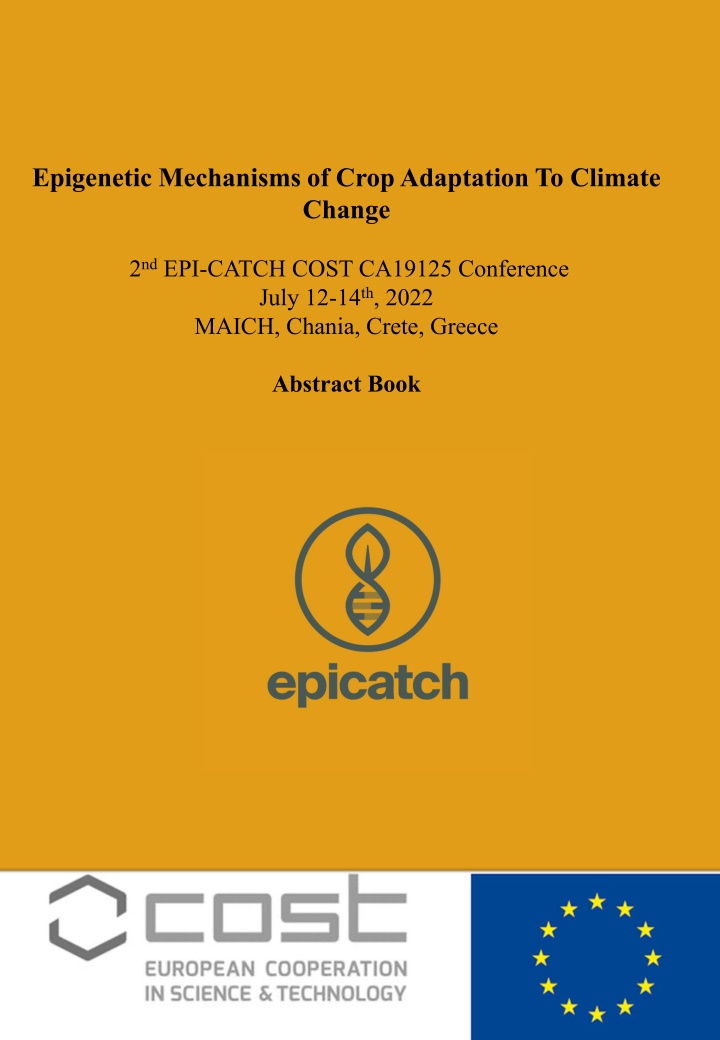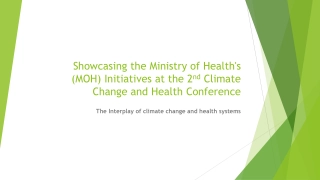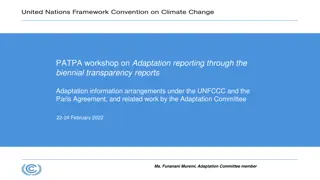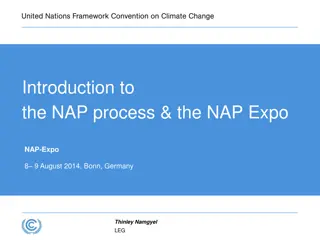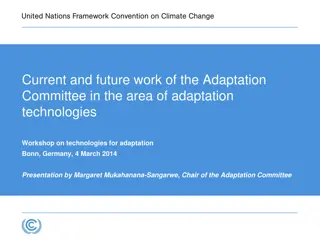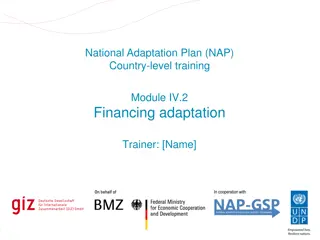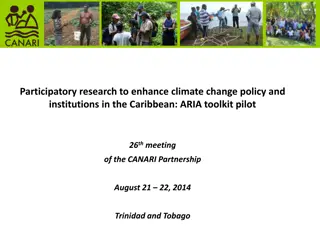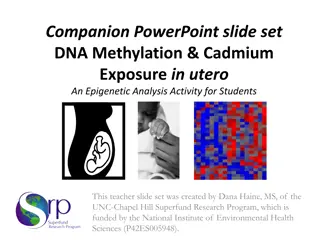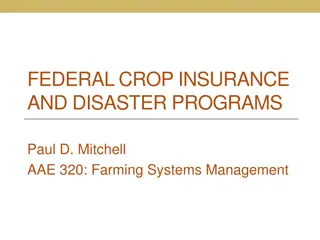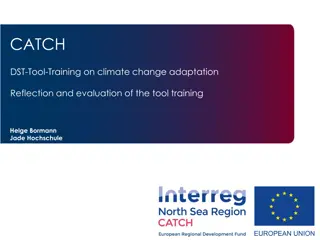Epigenetic Mechanisms of Crop Adaptation to Climate Change
Epigenetic mechanisms, such as DNA methylation, play a crucial role in plants' adaptation to environmental stressors. Asexual plant lineages offer insights into the dynamics of DNA methylation and gene expression modulation. This abstract discusses the stability and transgenerational effects of stress-induced DNA methylation variants, highlighting research findings from different asexual systems like clonal duckweed and Lombardy poplar.
Uploaded on Feb 27, 2025 | 0 Views
Download Presentation

Please find below an Image/Link to download the presentation.
The content on the website is provided AS IS for your information and personal use only. It may not be sold, licensed, or shared on other websites without obtaining consent from the author.If you encounter any issues during the download, it is possible that the publisher has removed the file from their server.
You are allowed to download the files provided on this website for personal or commercial use, subject to the condition that they are used lawfully. All files are the property of their respective owners.
The content on the website is provided AS IS for your information and personal use only. It may not be sold, licensed, or shared on other websites without obtaining consent from the author.
E N D
Presentation Transcript
Epigenetic Mechanisms of Crop Adaptation To Climate Change 2nd EPI-CATCH COST CA19125 Conference July 12-14th, 2022 MAICH, Chania, Crete, Greece Abstract Book
ORAL PRESENTATION ABSTRACTS 2nd EPICATCH CA19125 Conference, July 12-14th, 2022, Chania, Greece 1
ENVIRONMENTAL AND TRANSGENERATIONAL DYNAMICS OF DNA METHYLATION IN ASEXUALLY REPRODUCING PLANTS Koen J F Verhoeven Department Terrestrial Ecology, Netherlands Institute of Ecology (NIOO-KNAW), Wageningen, The Netherlands Correspondence: k.verhoeven@nioo.knaw.nl Epigenetic mechanisms such as DNA methylation are thought to mediate stable and potentially long-term responses to environmental stimuli. Asexually reproducing plant lineages are powerful models to address environmental and transgenerational dynamics of DNA methylation, because (1) methylation variation can be studied conveniently without confounding effects of genetic variation, and (2) asexual reproduction bypasses epigenetic resetting mechanisms that operate in germ lines of sexual species, thus potentially setting the stage for high transgenerational stability of induced DNA methylation variants. While DNA methylation variation is being explored in a rapidly growing number of plant species, basic questions remain poorly answered. How stress- and species-specific is the DNA methylation response to environmental stressors? How stable are environment-induced DNA methylation variants under asexual reproduction, and how does this link to observed patterns of natural DNA methylation variation in clonal systems? And to what extent is stress-induced DNA methylation variation associated with, or even causal to, gene expression modulation? Here I will present a selection of results from the recent EpiDiverse project, a H2020 Marie Curie Innovative Training Network, which aimed to address these questions. I will highlight results from different asexual systems, including clonal duckweed and the Lombardy poplar. 2nd EPICATCH CA19125 Conference, July 12-14th, 2022, Chania, Greece 2
PRC2 FUNCTION IN THE TRANSITION: GREEN OR NOT-GREEN Iva Mozgova 1,2, Kone n T 1,2, Samo N 1,2, Trejo Arellano M 1, Zhou M 1, Bu insk L 3, Ebert A 4, Kub sek J 2, Kopka J 4, Sobotka R 2,3, Richet-Bourbousse C 5 1 Biology Centre ASCR, Brani ovsk 31, esk Bud jovice, 37005, Czech Republic 2 University of South Bohemia Faculty of Science, Brani ovsk 31, esk Bud jovice, 37005, Czech Republic 3 Institute of Microbiology ASCR, Centre Algatech, Novohradsk 237, T ebo , 37981, Czech Republic 4 Max Planck Institute of Molecular Plant Physiology, Am M hlenberg 1, Potsdam, 14476, Germany 5 Institut de Biologie de l'Ecole Normale Sup rieure (IBENS), Ecole Normale Sup rieure, CNRS, INSERM, Universit PSL, Paris, France Correspondence: iva.mozgova@umbr.cas.cz Polycomb Repressive Complex 2 (PRC2) is well established to repress seed maturation transcriptional programme during seedling establishment [1,2]. Recently, we uncovered a role for PRC2 in stable transition to photoautotrophic growth and in moderation of light response during photomorphogenesis. We identified sets of nuclear-encoded genes related to light signalling and photosynthesis, that are targeted by H3K27me3, and we detected enrichment of processes related to light response among genes upregulated in mutant seedlings. In agreement, we observe altered light-responsive phenotypes during photomorphogenesis and enhanced light sensitivity of PRC2 mutant plants. Here, I will present our current research directions aiming to understand the function of PRC2 in the seed-to-seedling metabolic and developmental transition. Funding: GACR (16-08423Y), Lumina quaeruntur (LQ200961901), INTER-COST (LTC19050) References: 1. Bouyer, D. et al. (2011) Polycomb repressive complex 2 controls the embryo-to-seedling phase transition. PLoS Genet 7, e1002014. doi: 10.1371/journal.pgen.1002014 2. Yan, B. et al. (2020): Knowing when to silence: roles of polycomb-group proteins in SAM maintenance, root development, and developmental phase transition. Int J Mol Sci 21:1 19. doi: 10.3390/ijms21165871 2nd EPICATCH CA19125 Conference, July 12-14th, 2022, Chania, Greece 3
MOLECULAR MECHANISMS OF INDUCED HERITABLE GENETIC AND EPIGENETIC CHANGES IN ARABIDOPSIS AND CROP PLANTS Peng H, Roquis D, Katouzi M, Robertson M, Lopez M E and Etienne Bucher Crop Genome Dynamics Group, Agroscope, Switzerland Correspondence: etienne.bucher@agroscope.admin.ch Accelerating climate change and ongoing wars have reminded us of the importance of wheat to feed the global population. It has further highlighted the central role that crop breeding must take to contribute to alleviate these challenges. And yet, even though the emergency could not be clearer, all innovations in crop breeding are being blocked in Europe. In this presentation, I will present you how my group has developed a novel crop breeding method that is based on drug- induced genetic and epigenetic changes and how European legislators effectively prohibited its use. Transposable elements are stress-responsive genetic elements that have been key drivers of domestication of important crops. Here, our aim is to accelerate this process by temporarily releasing transposable element mobility by using epigenetic drugs in combination with abiotic stresses. First, I will show you in Arabidopsis how controlled mobilization of transposable elements can change stress responsiveness of the plant and thereby contribute to rapid stress adaptation. We also found that treatments with epigenetic drugs could lead to stable epigenetic changes that can affect gene expression. I will then present recent data that we have obtained in key crops such as rice and wheat suggesting that induced transposable element mobilization could be a useful tool to accelerate crop breeding. Indeed, preliminary data suggests that this method may result in pathogen resistance in wheat. In conclusion, the presented crop breeding method could render plants more tolerant to climate change and reduce pesticide use, but not in Europe if the legislation does not change. 2nd EPICATCH CA19125 Conference, July 12-14th, 2022, Chania, Greece 4
THE EPIGENETIC DRIVERS OF PLANT IMMUNE MEMORY Parker AH, Wilkinson S, Furci L & Juriaan Ton School of Biosciences, University of Sheffield, UK Correspondence: j.ton@sheffield.ac.uk After recovery from stress by pests and diseases, plants maintain an elevated state of defence. This induced resistance (IR) is often based on immune priming, which enables the plant to mount a faster and stronger defence response to future attacks. We study the epigenetic basis of this plant immune memory, which stems from our earlier finding that diseased Arabidopsis plants prime the immune system of their offspring. Although variable in intensity, the strength and durability of the transgenerational IR is proportional to the stress encountered in previous generations and is dependent on ROS1-dependent DNA demethylation of transposable elements (TEs). To gain a better mechanistic insight in the epigenetic drivers of the response, we employ artificial strategies to manipulate the DNA methylome and study impacts on plant immune responsiveness. Previously, we have used epigenetic recombinant inbred lines (epiRILs) of Arabidopsis, which share the same genetic background as wild-type plants but vary in heritable regions of reduced DNA methylation from the drm1-2 mutant. Using this resource, we identified four epigenetic TE-rich regions that prime global defence gene expression and provide high levels of disease resistance without concomitant costs on plant growth. To translate this epigenetic disease resistance from Arabidopsis to crops, we are currently developing a new epigenetic breeding tool to introduce dosed amounts of ROS1-dependent DNA hypo-methylation in plant genomes. This tool will not only allow us to select for crop varieties that are epigenetically primed against plant diseases, but also explore the spatiotemporal mechanisms by which DNA methylation homeostasis controls plant immune memory. 2nd EPICATCH CA19125 Conference, July 12-14th, 2022, Chania, Greece 5
EPIGENETICS DYNAMICS AS CENTRAL DRIVER OF HEAT STRESS RESPONSE AND MEMORY ACQUISITION PROCESSES IN PINUS RADIATA Monica Meijon, Lamelas L, Roces V, Escand n M, Ca al MJ, Valledor L Plant Physiology, Department of Organisms and Systems Biology, Faculty of Biology and Biotechnology Institute of Asturias, University of Oviedo, Oviedo, Asturias, Spain Correspondence: meijonmonica@uniovi.es In the current scenario of climate change the heatwaves are increasing their importance among the most common abiotic stresses for plants species, causing huge economic loses, limiting plant growth and productivity and changing species distribution limits, accelerating the decline of natural populations. Their impact over plants at physiological and molecular levels has been a hot topic for plant physiologists over the decades, but there is still scarce information about how plants respond and adapt to this stressor. The last years our group has been focused on studying how long-lived plants as Pinus radiata respond, acclimatize, remember, and learn from heat stress. Through these works, we identified several epigenetic- and splicing driven candidates as central regulators of recovery and memory acquisition processes. Nuclei exhibited differential proteome profiles across heat stress and recovery, being noteworthy H2A histone and methyl cycle enzymes accumulated after the first stress period and increased specific nucleolar or nucleoid activities related to retrograde signalling. Furthermore, in silico analysis of RNA-seq data showed alternative splicing (AS) as one of the main forces driving the heat stress response, revealing response and memory responsive isoforms; and hence, establishing AS as a core mechanism for the acquisition of long-term memory in conifers. Preliminary results also suggest that epigenetic mechanisms and differential micro RNAs accumulation in the seeds play a central role transferring the learned lessons from the mother to her siblings. These discoveries shed light on the molecular mechanisms that explain how long-lived plants can remember past stresses and transmit this information to their progenies, supporting the development of new breeding strategies to face the challenges that the climate change will impose to forests. Acknowledgements: This work is an output of the PID2019-107107GB-I00 and PID2020- 113896GB-I00 projects financed by the Spanish Ministry of Science and Innovations. 2nd EPICATCH CA19125 Conference, July 12-14th, 2022, Chania, Greece 6
EPIGENETIC REGULATION OF HEAT STRESS RESPONSE DURING SEED GERMINATION Malabarba J 1, Chen Z 1, Windels D 1, Xu W 2 and Jerome Verdier 1,2 1 University of Angers, Institut Agro, INRAE, IRHS, SFR QUASAV, F 49000 Angers, France 2 Shanghai Center for Plant Stress Biology and CAS Center for Excellence in Molecular Plant Sciences, Chinese Academy of Sciences, Shanghai 200032, China Correspondence: jerome.verdier@inrae.fr Seed development needs the coordination of multiple molecular mechanisms to promote correct tissue development, seed filling, and the acquisition of germination capacity, desiccation tolerance, longevity, and dormancy. Heat stress can negatively impact these processes and upon the increase of global mean temperatures, global food security is threatened. Here, we explored the impact of heat stress on seed physiology, morphology, gene expression, and epigenetic changes on three stages of seed development and two stages during seed germination. By analyzing candidate epigenetic markers using the mutants physiological assays, we observed that DNA methylation and histone marks greatly participate into the acquisition of seed germination quality traits, especially when seeds have been produced under stressful conditions. To illustrate this process, Arabidopsis Col 0 plants under heat stress presented a decrease in germination capacity as well as a decrease in longevity. We observed that upon mild stress, gene expression and DNA methylation were moderately affected. Nevertheless, upon severe heat stress during seed development, gene expression was intensively modified, promoting heat stress response mechanisms including the activation of the ABA pathway. On the other hand, we also observed that upon severe stress, a large proportion of differentially methylated regions (DMRs) were located in the promoters and gene sequences of germination related genes, including a UTR region of a recently identified genes involved in the seed germination plasticity, called MIEL1. To conclude, our results indicate that changes in DNA (de)methylation and histone marks could be a key regulatory process to ensure proper seed germination of seeds produced under heat stress. 2nd EPICATCH CA19125 Conference, July 12-14th, 2022, Chania, Greece 7
TREES FACING CLIMATE CHANGE: DNA METHYLATION INVOLVED IN PLASTICITY AND ADAPTATION Stephane Maury 1, Sow M D1,9, Vigneaud J1, Fichot R1, Duplan A1, Toumi A1, Delaunay A1, Le Jan I 1, Allona I 2,3, Strauss S H 4, Venneault-Fourrey C 5, Kohler A5, Trontin J F 6, Miguel C7, In cio V 7, Lelu-Walter M A 8, Segura V 8, Rogier O 8, Salse J 9, Ambroise C 10, Tost J 11, Plomion C 12 1 LBLGC, INRAE, Universit d Orleans, EA 1207 USC 1328, Orl ans 45067, France 2 Centro de Biotecnolog a y Gen mica de Plantas, Universidad Polit cnica de Madrid (UPM) Instituto Nacional de Investigaci n y Tecnolog a Agraria y Alimentaria (INIA), Campus de Montegancedo UPM, Pozuelo de Alarc n, 28223 Madrid, Spain 3 Departamento de Biotecnolog a-Biolog a Vegetal, Escuela T cnica Superior de Ingenier a Agron mica, Alimentaria y de Biosistemas, Universidad Polit cnica de Madrid (UPM), 28040 Madrid, Spain 4 Department of Forest Ecosystems and Society, Oregon State University, Corvallis, OR 97331- 5752, USA 5 Universit de Lorraine, INRAE, UMR 1136 Interactions Arbres-Microorganismes, Centre INRAE Grand Est-Nancy, 54280 Champenoux, France 6 FCBA BioForBois, P le Industrie Bois & Construction, Campus For t-Bois de Pierroton, 71 Route d'Arcachon, Cestas, 33610, France. 7 BioISI-Biosystems & Integrative Sciences Institute, Faculty of Sciences, University of Lisboa, 1749-016 Lisboa, Portugal. 8 BioForA, INRAE, ONF, UMR 0588, 45075 Orl ans, France. 9 GDEC - INRAe, Clermont-Ferrand, France 10 Laboratory for Epigenetics and Environment Centre National de Recherche en G nomique Humaine, CEA- Institut de Biologie Francois Jacob, Universit Paris-Saclay, Evry 91000, France 11LaMME University Evry, Evry, France 12 Biogeco INRA University Bordeaux, Cestas, France Correspondence: stephane.maury@univ-orleans.fr Forest die-off is reported all around the world due to heat and drought stress episodes. As fixed and long living organisms subjected to repeated environmental stresses, trees have developed mechanisms enabling them to cope with fluctuating environmental conditions. We proposed epigenetics as a hub of integration in meristematic cells linking developmental and hormonal responses with changing environment. This was based on our studies in the shoot apical meristem of the model tree, poplar, under water deficit conditions using modified lines (RNAi) for DNA methylation (Lafon-Placette et al., 2018; Le Gac et al., 2018; Maury et al., 2019; Sow et al., 2021). Our objective is now to evaluate how DNA methylation can significantly participate to plasticity and adaptation in trees facing climate change in order to test potential uses for trees breeders and forest managers (Sow et al., 2018; Amaral et al., 2020; Kakoulidou et al., 2021). We will present new data about the epigenetic control of mutualistic interactions in trees but also about epigenetic memory of drought stress in poplar or temperature sensed at the embryo stage in adult Pine trees. Finally, we will discuss about the EPITREE project (2018- 2023) that evaluates the adaptive potential of DNA methylation variations in natural tree populations (Poplar and Oak). 2nd EPICATCH CA19125 Conference, July 12-14th, 2022, Chania, Greece 8
STRESS-INDUCED SWITCH OF MICROSPORE FATE TOWARDS EMBRYOGENESIS INVOLVES GLOBAL HISTONE ACETYLATION INCREASE IN BRASSICA NAPUS Yolanda P rez-P rez 1, Berenguer E 1, Carneros E 1, Rueda-Varela C 1, Sol s M T 2, Testillano P S 1 1 Pollen Biotechnology of Crop Plants Group, Biological Research Center Margarita Salas, CIB-CSIC, Ram ro de Maeztu, 9, 28040, Madrid, Spain 2 Departament of Genetics, Microbiology and Physiology, Fac. Biology, UCM, Ciudad Universitaria, 28040, Madrid, Spain Correspondence: testillano@cib.csis.es In vivo, microspores divide and follow the gametophytic program to produce mature pollen grains. However, in vitro, in response to stress treatments, microspores can be reprogrammed to become totipotent cells that follow an embryogenic pathway producing haploid and double- haploid embryos, important biotechnological tools in plant breeding. Stress-induced microspore reprogramming and totipotency acquisition involves repression and/or activation of numerous genes associated with the new developmental program as well as changes in global genome organization. Epigenetic modifications are key factors contributing to the functional status of chromatin that regulate gene expression during cell proliferation and differentiation. Histone acetylation is one of mayor epigenetic marks controlling gene expression during plant development and in response to environment. In this work, we have analysed the level and distribution patterns of the key histone epigenetic mark H3/H4 acetylation as well as the expression patterns of histone acetylase BnHAT5-like, during pollen development and microspore embryogenesis, in Brassica napus L. Results have shown that both microspore pathways, gametophytic and embryogenic, were epigenetically regulated and that microspore reprogramming to a different cell fate involved changes in the level and distribution of H3/H4ac, correlating with BnHAT5-like expression profiles. Gametophytic development and pollen maturation involved a progressive decrease of histone acetylation, mainly in generative and sperm nuclei of pollen grain. In contrast, microspore reprogramming, totipotency acquisition and embryogenesis initiation were associated with high levels of histone H3 and H4 acetylation, in early proembryo nuclei. Treatments with suberoylanilide hydroxamic acid (SAHA), inhibitor of histone deacetylase, increased global histone acetylation levels, promoted microspore reprogramming and enhanced embryogenesis initiation rate, while it induced expression of embryogenesis marker genes such as BnAGL15, BnFUS3 and BnLEC2. Taken together, results indicate that histone H3/H4 acetylation favours microspore reprogramming, totipotency acquisition and embryogenesis initiation, while pollen maturation involves decreasing histone acetylation. Moreover, these findings provide new insights into the epigenetic mechanisms that regulate microspore reprogramming, opening up new possibilities to enhance microspore embryogenesis initiation in crop species through pharmacological modulation of histone acetylation by using small compounds that target histone modifier enzymes. Work supported by Project grant PID2020-113018RB-I00, funded by MCIN/AEI/ 10.13039/501100011033. 2nd EPICATCH CA19125 Conference, July 12-14th, 2022, Chania, Greece 9
EXPLORING THE ROLE OF EPIGENETIC IN LONG-LASTING POST- HARVEST RESISTANCE IN TOMATO Katie Stevens, Pastor V, Roberts M, Catoni M, Luna E School of Biosciences, University of Birmingham, Birmingham, United Kingdom Tomato is a major crop world-wide however its production is heavily limited by Botrytis cinerea, the causal agent of grey mould. Due to the toxicity of post-harvest pesticide application, alternative control methods for disease management such as priming are being investigated. In tomato fruit we have demonstrated that priming by the chemical -aminobutyric acid results in long lasting resistance against B. cinerea which is not observed when BABA is applied to older plants (12 weeks). Priming is associated with epigenetic changes such as DNA methylation which ultimately alter gene expression. Our work has shown that priming seedlings (2 weeks old) results in both long lasting and transgenerational resistance. This work explores how changes in DNA methylation mark long lasting priming in fruit and explores the hypothesis that young plants display a greater epigenetic imprinting capacity. Using whole genome bisulphite sequencing analysis (WGBS), differentially methylated regions (DMRs) specific to the phenotype of long-lasting resistance have been identified. Our results illustrate that BABA treatment impacts CHH context methylation depending on timepoint of application, confirming our hypothesis. Interestingly however, changes in CHH methylation after BABA treatment are not maintained throughout the life of the plant. A transcriptomic analysis on B. cinerea infected fruit from early and late BABA treated plants identified differentially expressed genes (DEGs) associated with resistance against B. cinerea. By overlapping our DEGs of interest with our resistance associated DMRs we have identified markers of long-lasting priming in tomato fruit which could serve for targets of durable resistance in other crops. 2nd EPICATCH CA19125 Conference, July 12-14th, 2022, Chania, Greece 10
CHEMICALLY-INDUCED SOMATIC EMBRYOGENESIS YIELD FOR QUERCUS SUBER L. REGENERATION AND BREEDING DNA DEMETHYLATION IMPROVES Elena Carneros, Esteban M. D az-Luzza, Yolanda P rez-P rez, Ivett B r ny, Pilar S. Testillano Pollen Biotechnology of Crop Plants Group, Biological Research Center Margarita Salas, CIB-CSIC, Ram ro de Maeztu, 9, 28040, Madrid, Spain Correspondence: testillano@cib.csis.es Plant in vitro regeneration systems, like somatic embryogenesis (SE), are essential players in breeding, since they permit to propagate elite genotypes, to produce double-haploids and to convert gene editing or transformation events into plants. However, in many crop and forest species SE is highly inefficient. Cell reprogramming and SE initiation involve changes in global genome organization in which DNA methylation plays a key role. Several studies have reported changes in DNA methylation during in vitro morphogenic processes in some herbaceous species, but there is very limited information about DNA methylation dynamics during SE in trees. This work analyses the changes in global DNA methylation levels, nuclear distribution of methylated DNA and expression of DNA methyltransferase genes, as well as the effect of the DNA demethylating agent 5'-Azacytidine (AzaC) in Quercus suber somatic embryogenesis. Results showed reduction of global DNA methylation levels after SE induction and early stages of SE, in proembryogenic masses, followed by an increase of methylation during embryo differentiation. This pattern correlated with expression profiles of several DNA methyltransferase genes. AzaC treatment reduced global DNA methylation, while enhanced SE induction rate and promoted proembryogenic masses proliferation; however, it prevented further embryo development. AzaC removal from culture medium restored embryo development and led to the formation of higher number of embryos compared with control cultures. These findings open the way for new strategies using small molecule epigenetic modulators to enhance somatic embryogenesis yields for forestry breeding programs. Work supported by Project grant PID2020-113018RB-I00, funded by MCIN/AEI/ 10.13039/501100011033. 2nd EPICATCH CA19125 Conference, July 12-14th, 2022, Chania, Greece 11
FAGACEAE HISTONE METHYLTRANSFERASES & DEMETHYLASES Sofia Alves1, Braga A 2, Parreira D 2, Alhinho A T 3, Nunes Ramos M J 1*, Silva H 3, Ribeiro Costa M M 3, Morais-Cec lio1L 1 1 LEAF Linking Landscape, Environment, Agriculture and Food Research Center, Associated Laboratory TERRA, Instituto Superior de Agronomia, University of Lisbon, Tapada da Ajuda, 1349-017 Lisboa, Portugal 2 Instituto Superior de Agronomia, University of Lisbon, Tapada da Ajuda, 1349-017 Lisboa, Portugal 3 Centre of Molecular and Environmental Biology (CBMA), University of Minho, Campus de Gualtar, 4710-057 Braga, Portugal * Current address: GenoMed, Diagn sticos de Medicina Molecular, SA, Lisboa, Portugal Fagaceae is a family of trees and shrubs distributed throughout the northern hemisphere, comprising highly economically and ecologically important species, due to the value of its fruits and wood. Epigenetic regulation is a process by which gene expression is modulated, which involves changes in chromatin, either at the DNA or at the histone levels. Histone methylation is an epigenetic change performed by histone methyltransferases (HMTs) that act by adding a methyl group in certain amino acid residues of the histone tails, leading to gene activation or repression depending on the position of the changed residue. This methylated state can be reversed by the action of Histone demethylases (HDMTs). To characterize these proteins in different species of Fagaceae, freely available RNA-seq libraries were used to de novo assemble transcriptomes of Castanea (C. sativa and C. henryi) and Fagus (F. grandifolia). These data, together with the published genomes of F. sylvatica, F. crenata, Quercus suber, Q. robur, Q. lobata, C. crenata, C. dentata and C. mollissima, were used to identify 32 HMTs with representatives in the six described classes, and 21 HDMTs with members in both known classes, all with orthologs in Arabidopsis thaliana. The presence of paralogs was evaluated for each species. Considering all species, HMTs show more gene duplications than HDMTs, with higher number of paralogs observed in Quercus and Castanea genera. Phylogenetic trees using Maximum Likelihood as optimization criteria were created for each HMTs and HDMTs classes, using protein sequences of the studied Fagaceae and Arabidopsis orthologs. The generated trees individualise gene clusters according to the expected genera and species phylogenetic relationships supported by good bootstrap values. This study will facilitate further studies in Fagaceae concerning the regulation of critical developmental processes and environmental responses modulated by histone methylation or demethylation. Funding: FCT project grant POCI-01-0145-FEDER-027980/PTDC/ASP-SIL/27980/2017- FlowerCAST. Sofia Alves was funded by the FCT grant SFRH/BD/146660/2019. 2nd EPICATCH CA19125 Conference, July 12-14th, 2022, Chania, Greece 12
ENGINEERING EPIGENETIC RESISTANCE TO PLANT DISEASE Abhaya M Dandekar 1 Plant Sciences Department, University of California Davis, 1 Shields Ave, Davis CA 95616, USA Correspondence: amdandekar@ucdavis.edu High value orchard and vineyard crops planted in millions of acres worldwide continue to be susceptible to chronic disease and pests that reduce their productivity, degrade the quality of their products and damage grower and industry returns. Global climate change is poised to make matters much worse by increasing host plant disease susceptibility while at the same time selecting for more virulent pathogens. Crown gall disease is one such widespread problem of orchard and vineyard crops that in spite of the discovery of the causative pathogen in the mid- 19th century and an incredible detailed understanding of its epidemiology and virulence mechanisms in the last 50 years continues to be a significant unsolved chronic disease problem. We have focused on the plant host perspective to eliminate the gall and thus the disease by engineering epigenetic resistance that is mediated by RNAi suppression of oncogene expression that is essential for gall formation and thus the propagation of the disease in the environment. The oncogenes that mediate gall formation are highly conserved among gall forming strains of Agrobacterium and encode for the synthesis of auxin and cytokinin biosynthesis. These oncogenes are acquired and transmitted horizontally via plasmids in orchard and vineyard systems. We also pioneered the ability to transform somatic embryos using Agrobacterium- mediated transformation germinating whole plants from transformed somatic embryonic stem cells that can be vegetatively propagated providing a facile pathway to introduce and edit genomic information for some orchard and vineyard crops. In orchards and vineyards worldwide, the tree/vines are almost exclusively composite where locally adapted rootstocks provide disease and pest resistance to the commercially significant scion varieties that produce high-quality products. We will demonstrate how rootstock genotypes that are a key component of orchard and vineyard systems are highly susceptible crown gall but can be engineered to provide resistance to crown gall formation and potentially to stack resistance to other diseases and pests. 2nd EPICATCH CA19125 Conference, July 12-14th, 2022, Chania, Greece 13
CHROMATIN-MEDIATED UNFAVOURABLE ENVIRONMENTAL CONDITION IN CROPS ADAPTIVE STRATEGIES TO Serena Varotto 1, Forestan C 2, Canton M 1, Marconi G 3 and Bonghi C 1 1 University of Padova DAFNAE Viale dell Universit , 16 35020 Legnaro (PD) 2 Department of Agricultural and Food Sciences (DISTAL), University of Bologna, 40127 Bologna (BO), Italy 3Department Agricultural, Food and Environmental Sciences, University of Perugia, 06121 Perugia, Italy Correspondence: serena.varotto@unipd.it When subjected to unfavourable environmental conditions, plants rapidly respond and adapt through a sophisticated variety of physiological, biochemical, transcriptional, and epigenetic mechanisms. Dynamic changes in chromatin structure and concomitant transcriptional variations play an important role not only in stress response but also in adaptive mechanisms for integrating environmental conditions and appropriate developmental programs over the time. To investigate the mechanisms of plant adaptation to environmental unfavourable conditions we use to different crop plant processes: maize plants response to a mild and prolonged drought stress just before the flowering transition, and peach flower bud development during the cold season. In maize water stress was followed by a complete recovery period. We found that the extensive transcriptional and chromatin changes present soon after the stress application were only partially reset after the recovery stage, and impact on maize flowering. We have further evaluated water stress response and expression of stress-memory genes in the offspring of plants subject to repeated cycles of stress pressure, which genome was re-sequenced at the sixth generation. Drought stress was indeed applied to five subsequent generations of maize plants, to assess the transgenerational drought stress memory. Peach a deciduous fruit trees has evolved adaptive mechanisms, such as bud dormancy, to survive the critical environmental conditions. Tree buds enter in a state during which visible growth is limited and after the exposure to low temperature and fulfilment of bud chilling requirements, early spring promotes growth reactivation. An insufficient chilling exposure may lead to the abortion of the reproductive whorls and non-uniform blooming. Our recent studies demonstrate that there is no dormancy and growth cessation in peach flower buds during winter chilling accumulation. Changes at the transcript level of key genes associated with hormone metabolism and flower bud development as well as chromatin modifications have been identified to display a role during cold development. 2nd EPICATCH CA19125 Conference, July 12-14th, 2022, Chania, Greece 14
LIGHT AND WARM TEMPERATURE INDUCE CHANGES IN THE NUCLEAR ORGANIZATION OF ARABIDOPSIS Eirini Kaiserli Institute of Molecular, Cell and Systems Biology, Bower Building, University of Glasgow, Glasgow, G12 8QQ, UK Correspondence: eirini.kaiserli@glasgow.ac.uk Photomorphogenesis and flowering initiation are two of the most dramatic developmental transitions during the life-cycle of a plant that are triggered by an ensemble of environmental and endogenous stimuli and signalling networks. The talk will focus on the molecular function of TZP (TANDEM ZINC-FINGER PLUS3) as an integrator of light and ambient temperature signalling at the level of transcription. TZP is a unique nuclear protein that acts as a scaffold bridging signalling pathways that promote plant growth and seedling development during de- etiolation and flowering initiation. TZP is recruited to red light-induced nuclear photobodies via a direct interaction with the red-light and thermo-receptor phytochrome B. Furthermore, TZP controls hypocotyl elongation and flowering initiation by modulating the expression of chromatin regulators. Recent studies uncovering the novel role of TZP in thermomorphogenesis will be presented. 2nd EPICATCH CA19125 Conference, July 12-14th, 2022, Chania, Greece 15
INTEGRATING EPIGENETIC AND POPULATION GENOMIC DATA: THE FITNESS CONSEQUENCE MAP OF RICE Michael Puruggunan 1 Correspondence: 2nd EPICATCH CA19125 Conference, July 12-14th, 2022, Chania, Greece 16
MATERNAL STRESS IN FOREST TREES AFFECT SUSCEPTIBILITY TO STRESS IN OFFSPRING Alejandro Solla 1 Faculty of Forestry, Institute for Dehesa Research (INDEHESA), University of Extremadura, Avenida Virgen del Puerto 2, 10600 Plasencia, Spain Correspondence: asolla@unex.es Maternal effects are influences of the mother plant on the phenotype of her offspring via mechanisms other than the genetic information carried on chromosomes. These effects are also linked to transgenerationalplasticity , an important new evolutionary concept. Several examples on how maternal stress in forest trees affect susceptibility to stress in offspring are provided. An unfavourable (biotic) maternal environment for Castanea sativa and Quercus ilex trees increased the tolerance to Phytophthora cinnamomi in offspring (Camis n et al., 2019, Vivas et al., 2021). In Alnus lusitanica, maternal stress induced by Phytophthora xalni did not affect susceptibility to stress in offspring. However, an unfavourable (abiotic) maternal environment for Pinus pinaster and Q. brantii increased susceptibility to Fusarium circinatum and drought stress in offspring, respectively (Vivas et al., 2013; Zolfaghari et al. 2022). It seems that different types of stress affecting mother trees trigger different responses in the next generation. While small-size offspring usually show increased tolerance to biotic stress at a cost of plant growth, heavy stress experienced by the mother trees involves exceeding the threshold for a beneficial effect in offspring. References: Camis n A, Mart n MA, Oliva J, Elfstrand M, Solla A, 2019. Increased tolerance to Phytophthora cinnamomi in offspring of ink-diseased chestnut (Castanea sativa Miller) trees. Ann. For. Sci. 76, 119 Vivas M, Zas R, Sampedro L, Solla A, 2013. Environmental maternal effects mediate the resistance of maritime pine to biotic stress. PloS one, 8, e70148. Vivas M, Hern ndez J, Corcobado T, Cubera E, Solla A, 2021. Transgenerational induction of resistance to Phytophthora cinnamomi in Holm oak. Forests 12, 100. Zolfaghari R, Dalvand F, Fayyaz P, Solla A, 2022. Maternal drought stress on Persian oak (Quercus brantii Lindl.) affects susceptibility to single and combined drought and biotic stress in offspring. Env. Exp. Bot. 194, 104716. 2nd EPICATCH CA19125 Conference, July 12-14th, 2022, Chania, Greece 17
COMBAT FOR THE FUTURE: SEED PRIMING AND STRESS RESILIENCE Erna Karalija 1,2 1 Faculty of Science, University of Sarajevo, Zmaja od Bosne 33-35 ; 71000 Sarajevo, Bosnia and Herzegovina; 2 Department for Biology, University of Florence, Via Madonna del Piano, 6, 50019 Sesto Fiorentino FI Correspondence: erna.karalija@gmail.com; erna.k@pmf.unsa.ba Seed priming is a process of controlled rehydration of seeds with aim to induce seed metabolic processes initiating priming memory. Primed seeds have better response to stressors demonstrating increased tolerance against biotic and abiotic stress. It is considered that epigenetic modifications are likely involved in priming phenomena against stressors. Such modifications have been shown to lead to prolonged stress memory, with seed priming being implicated heavily in regulation of transcription in early phases of metabolic activation. Priming can influence plant stress tolerance by initiation of mild stress cue resulting in acclimation- similar response of the plant. Different type of molecules can be used in initiation of such responses, but exact mechanism and epigenetic changes induced under priming are still being investigated. Presented research investigates how different priming molecules affect the gene expression level in primed seeds and which genes could be correlated to better tolerance of abiotic stress. 2nd EPICATCH CA19125 Conference, July 12-14th, 2022, Chania, Greece 18
EPICORK - UNVEILING THE ROLE OF DNA METHYLATION IN PERIDERM AND LENTICEL FORMATION Vera In cio a, Prazeres R a, Milhinhos A a,b , Barros P c, Gra a J d, Miguel C M a and Morais-Cec lio L e a BioISI Instituto de Biosistemas e Ci ncias Integrativas, Faculdade de Ci ncias, Universidade de Lisboa, 1749-016, Lisboa, Portugal b Instituto de Tecnologia Qu mica e Biol gica Ant nio Xavier, Universidade Nova de Lisboa (ITQB NOVA), Av. da Rep blica, 2780-157 Oeiras, Portugal c Instituto de Tecnologia Qu mica e Biol gica Ant nio Xavier, Universidade Nova de Lisboa (ITQB NOVA), GPlantS, Av. da Rep blica, 2780-157 Oeiras, Portugal d Forest Research Center (CEF), Institute of Agronomy, University of Lisboa, 1349-017 Lisbon, Portugal e Linking Landscape, Environment, Agriculture and Food (LEAF), Institute of Agronomy, University of Lisboa, 1349-017 Lisbon, Portugal The periderm protects plants with secondary growth from adverse environmental conditions and is made up of cork cells produced by the phellogen. The cork phellogen (Quercus suber) produces an extraordinarily thick periderm and is currently the exclusive commercial source of cork. After cork removal, a traumatic periderm is formed that can be harvested making cork the cornerstone of the economic sustainability of cork oak woodlands in Portugal and worldwide. The cork mass is interrupted by lenticular channels, the so-called cork porosity, which, at high levels, strongly depreciates the quality of cork. The factors that determine the quality of cork are unknown, however, recent studies have shown an association between epigenetics and phenotypes directly linked to phellogen activity: (I) variations in DNA methylation are associated with cork contrasting phenotypes directly linked to phellogen activity; (II) opposite global DNA methylation levels are observed in corks with contrasting phenotypes (higher vs. lower porosity); (III) DNA methyltransferases genes expression is correlated with cork quality traits; and (IV) de novo DNA methyltransferase gene expresses at high levels during cork formation. Owing to constraints in using cork oak for functional studies via genetically modified plants, the hypothesis of a causal relationship between DNA methylation and the cork phenotypic variability will be tested using potato periderm as a model system. The specific aim is to explain how DNA methylation modulates native and wound periderm formation and lenticel development by producing and further phenotyping loss-of-function DNA methyltransferase mutants in potato. The DNA methyltransferases genes MET1, DRM1, DRM2, CMT2, and CMT3 will be specifically knocked-out in phellogen cells using an expression-inducible CRISPR/Cas9 system, that combines previously described phellogen- specific promoters highly expressed in lenticular phellogen with an estrogen inducible XVE system. 2nd EPICATCH CA19125 Conference, July 12-14th, 2022, Chania, Greece 19
SMARTSUN PROJECT USING EPIGENETICS FOR CREATING CLIMATE-SMART SUNFLOWER FOR FUTURE CHALLENGES Dragana Miladinovi 1*, Cveji S 1, Joci S 1, Radanovi A 1, Jockovi M 1, Dedi B 1, Gvozdenac S 1, Hladni N 1, Kondi - pika A 1, Hrnjakovi O 2, Jockovi J 3, Lukovi J 3 1 Institute of Field and Vegetable Crops, Novi Sad, Serbia 2 Faculty of Technical Sciences, Novi Sad, Serbia 3 Faculty of Sciences, Novi Sad, Serbia Correspondence: *dragana.miladinovic@ifvcns.ns.ac.rs Among the effects of wide-ranging climate change, drought presents a significant threat to global agricultural production. In Serbia, climate change results in longer drought periods, which profoundly affect agricultural production. Sunflower is the main oilseed crop grown in Serbia and, due to its moderate drought tolerance, may become the oil crop of preference in the future. Better understanding of plant adaptation to drought is of great interest to both crop science and the society as a whole. Hence, SmartSun exploits the holistic approach combining studies of phenotyping and epigenetic mechanisms which modulate sunflower adaptation to drought stresses driven by climate change. The phenotyping tools include the digital root phenotyping and root anatomic characterization, while epigenetic analysis will imply small RNA and lncRNA expression profile differences in drought tolerance. Using statistical and machine learning techniques, SmartSun aims to link the data obtained from phenotyping and epigenetic tests to create climate-smart sunflower genotypes that will respond to the variable, unstable, and drought environmental growth conditions. The SmartSun will combine the expertise of a broad range of disciplines, bringing together sunflower breeders, biotechnologists, plant anatomists, plant stress researchers and bioinformaticians. The project will contribute to the development and introduction of epigenetic tools, such as epiQTLs, in sunflower breeding and it will promote the development of crop cultivars adapted to growers needs and challenges caused by climate change, which is one of the goals of the European Green Deal climate-neutral agricultural production. Acknowledgements: This work is supported by the Ministry of Education, Science and Technological Development of Republic of Serbia, grant number 451-03-68/2022-14/ 200032, by the Science Fund of the Republic of Serbia, through IDEAS project Creating climate smart sunflower for future challenges (SMARTSUN) grant number 7732457, by Center of Excellence for Innovations in Breeding of Climate-Resilient Crops - Climate Crops, Institute of Field and Vegetable Crops, Novi Sad, Serbia, and based upon work from COST Action EPI-CATCH (CA19125), supported by COST (European Cooperation in Science and Technology). www.cost.eu. 2nd EPICATCH CA19125 Conference, July 12-14th, 2022, Chania, Greece 20
PARENTAL PERICENTROMERIC METHYLATION STATUS DRIVES METHYLOME REMODELING AND HETEROSIS IN ARABIDOPSIS HYBRIDS Ioanna Kakoulidou 1, Piecyk R S 1, Meyer R C 3, Altmann T 3, Johannes F 1,2 1 Technical University of Munich, Department of Molecular Life Sciences, Liesel-Beckmann str.2, Freising, 85354, Germany 2 Technical University of Munich, Institute for Advanced Study (IAS), Lichtenbergstr. 2a., Garching, 8574, Germany 3 Leibniz Institute of Plant Genetics and Crop Plant Research (IPK), Department of Molecular Genetics, Corrensstrasse 3, Gatersleben, 06466, Germany The DNA methylomes of F1 hybrids undergo substantial remodeling relative to their parents. The extent to which this remodeling can be attributed to specific differentially methylated regions (DMRs) in the parental genomes and the contribution of the DMRs to phenotypic heterosis remain poorly understood (Lauss et al. 2018). Here we present the results of 500 epiHybrid families generated by crossing a male sterile plant to 500 different ddm1-derived epigenetic recombinant inbred lines (epiRILs) (Johannes et al. 2009). Methylome, transcriptome and phenotypic profiling was performed for a number of parents-hybrid trios. Our data reveals that hybrid methylomes display extensive remodeling mainly in non-CG contexts of pericentromeric regions. These remodeling events do not occur in isolation but co-vary substantially among distal regions both within and across chromosomes, thus indicating that methylome remodeling in hybrids is a highly coordinated process. Importantly, we could show that stably segregating parental pericentromeric DMRs (Colom - Tatch et al. 2012; Cortijo et al. 2014) can be used as predictors of local and distal remodeling events, and that they function as cis- and trans-acting expression quantitative trait loci, which are significantly associated with phenotypic heterosis. Our results establish a model by which parental methylation differences in heterochromatin- rich pericentromeric regions act as major re-organizers of hybrid methylomes and transcriptomes, which - in turn- drive non-additive phenotypic effects contributing to heterosis. References: Lauss K et al. 2018. Parental DNA methylation states are associated with heterosis in epigenetic hybrids. Plant Physiology. 10.1104/pp.17.01054 Johannes F et al. 2009. Assessing the impact of transgenerational epigenetic variation on complex traits. PLOS Genetics. 10.1371/journal.pgen.1000530 Colom -Tatch M et al. 2012. Features of the Arabidopsis recombination landscape resulting from the combined loss of sequence variation and DNA methylation. Proceedings of the National Academy of Sciences. 10.1073/pnas.1212955109 Cortijo S et al. 2014. Mapping the epigenetic bases of complex traits. Science. 10.1126/science.1248127 2nd EPICATCH CA19125 Conference, July 12-14th, 2022, Chania, Greece 21
RNA METHYLATION IS INVOLVED IN DARK-INDUCED SENESCENCE OF BARLEY (HORDEUM VULGARE) LEAVES Magda Grabsztunowicz 1, Rudy E 1, Tanwar U 1, Kubala S 2, Sobieszczuk- Nowicka E 1 1 Department of Plant Physiology, Faculty of Biology, Pozna Adam Mickiewicz University, 61- 614 Pozna , Poland 2 Institute of Biochemistry and Biophysics, Polish Academy of Sciences, 02-106 Warsaw, Poland Correspondence: mg@amu.edu.pl Global climate changes and world population growth enforce new improvement strategies for crop quality and yield. Novel directions to improve crop vitality and stress resistance emerged with epigenetics involving comprehensive mechanisms i.e. DNA and RNA methylation, modifications of histone proteins and ATP-dependent reorganization of nucleosomes. RNA methylations seem to be interesting and not fully understood yet processes that have been shown to have an effect on RNA processing, stability and export, thus being a new regulatory step in gene expression. Although RNA methylation has been proven to have ubiquitous effects on a plant s development and responses to various biotic and abiotic stresses, our understanding of those modifications in plant senescence remains unclear. Here, we have used Dark-Induced Leaf Senescence (DILS) model to study early and late events occurring in the senescence of barley leaves and the critical time limit for reversal of the senescence process that stops the leaves from reaching the cell death phase. Our microarray data followed by a real-time qPCR experiment show upregulation in several genes involved in RNA methylation throughout DILS. Among them, the gene encoding for N6-adenosine- methyltransferase MT-A70-like protein has been identified, which is an element of conserved m6A methyltransferase complex shown to catalyze m6A mRNA modification in plants. Moreover, 2-O-methyltransferase fibrillarin 2, RNA cap guanine-N2 methyltransferase domain- containing protein and rRNA large subunit methyltransferase J have been found strongly upregulated during DILS suggesting the complexity of RNA methylation processes involved in senescence events in barley plants. Our results are the first steps toward an understanding the connections between epitranscriptome and stress responses in plants, which may allow for the future establishment of the epitranscriptomic marks as important for the stress-tolerant crop plants development. This work was supported by the National Science Centre, Poland (project number 2018/30/E/NZ9/00827 to ES-N) 2nd EPICATCH CA19125 Conference, July 12-14th, 2022, Chania, Greece 22
LIPID METABOLIC ENGINEERING THROUGH STRESS PRIMED TRANSCRIPTIONAL REPROGRAMMING IN SEEDS Kaushal Kumar 1 Correspondence: 2nd EPICATCH CA19125 Conference, July 12-14th, 2022, Chania, Greece 23
WORLDWIDE PLANT BIOTECHNOLOGY INNOVATION LANDSCAPE FROM PATENTING TO MARKETING: WHAT ARE THE EUROPEAN WEAKNESSES? Marcel Kuntz 1 Correspondence: 2nd EPICATCH CA19125 Conference, July 12-14th, 2022, Chania, Greece 24
GENOME-ENGINEERING OF MICROPROTEINS IN MODEL AND CROP PLANTS Stephan Wenkel 1 Correspondence: 2nd EPICATCH CA19125 Conference, July 12-14th, 2022, Chania, Greece 25
IMPACT OF CADMIUM ON ER STRESS RESPONSE AND EPIGENETIC CHANGES IN A. THALIANA Angelo Santino 1 Correspondence: 2nd EPICATCH CA19125 Conference, July 12-14th, 2022, Chania, Greece 26
MOLECULAR AND EPIGENETIC MECHANISMS INVOLVED IN INHERITANCE OF ABIOTIC STRESS GERMINATION STAGE AFTER MATERNAL DROUGHT STRESS IN SUNFLOWER TOLERANCE AT THE Christophe Bailly a, Vancostenoble B a, Langlade N b a Sorbonne Universit , IBPS, CNRS, UMR 7622 Biologie du D veloppement, F-75005 Paris, France b LIPME, Universit de Toulouse, INRAE, CNRS, Castanet-Tolosan, France Correspondence: christophe.bailly@sorbonne-universite.fr Climate change produces more frequent and intense drought events during seed development that can affect seed quality. In addition seed germination is critical to ensure plant growth and reproductive success but it can also be impacted by various abiotic stresses, including drought stress. Here we have investigated the effects of drought stress during sunflower seed development on the mother plant on the germinative properties of the progeny. Interestingly drought stress during seed development provided tolerance to water, hypoxic, cold and salt stresses during seed germination and also induced lower dormancy. We established that the induction of these traits was not transgenerational but mostly maternally transmitted. A transcriptomic study demonstrated that the induction of water stress tolerance at the germination stage was associated with a conditional transcriptional memory. Interestingly it also showed that the adaptation to water stress had strong hormonal and redox components and that epigenetic mechanisms were also likely to play a role in the seed response to the maternal environment. Thus we also investigated the methylome of sunflower seeds using high-throughput DNA sequencing after bisulfite treatment. We characterized an intergenerational memory of the maternal stress in the progeny at the DNA methylome level. Differences of methylation were mostly acquired during seed development and at a global level drought increased CHG and reduced CHH methylation rates. However no simple relation was identified between methylation and regulation of gene expression. Altogether our results bring novel insights on the mechanisms involved in drought stress memory and open novel perspectives of applications in the context of sustainable sunflower crop production. 2nd EPICATCH CA19125 Conference, July 12-14th, 2022, Chania, Greece 27
REMEMBER THE RAIN: EPIGENETIC FACTORS REGULATING FLOOD STRESS MEMORY IN PLANTS Aida Maric 1, Gibbs D J 2, Hartman S 1* 1 CIBSS Centre for Integrative Biological Signalling Studies, University of Freiburg, Freiburg im Breisgau, Germany 2 School of Biosciences, University of Birmingham, Edgbaston, UK Correspondence: Sjon Hartman (email: johannes.hartman@biologie.uni-freiburg.de) Flooding events limit agricultural productivity and threaten food security globally. The changes in flooding patterns require fast plant acclimation in order to sustain growing food demand (Hirabayashi et al., 2013). Flooding dramatically reduces gas diffusion to/from the plant (Sasidharan et al., 2018). The changes in levels of metabolically important gasses trigger a molecular cascade of events that prepare the plant for subsequent impending oxygen deprivation (hypoxia) (Hartman et al., 2019). Recent studies report that an important regulatory layer to flooding-induced hypoxiagoes through epigenetic control of gene expression (Gibbs et al., 2018; Chakraborty et al., 2019). Epigenetic regulation has been extensively studied as a memory mechanism in eukaryotes (D'Urso and Brickner, 2014; Iwasaki and Paszkowski, 2014). This regulation is especially important for epigenetic memory of prior stresses, i.e. stress memory (L mke and B urle, 2017). However, to our knowledge, studies reported to date have not explored the existence and capacity of flooding stress memory in plants. We show that several plant species benefit from flooding stress memory, to improve tolerance to subsequent flooding events. Therefore, we investigate how plants encode flooding stress memory at epigenetic level. We have performed an RNA-Seq analysis of Arabidopsis plants exposed to flooding memory experiments. This analysis includes a VERNALIZATION 2 (VRN2) mutant that displayed a lack of flooding stress memory. Our results demonstrate a variety of tolerance genes that show flooding memory behaviour, with some of them being dependent on VRN2. Finally, we show that VRN2 is dependent on several flooding signals to exert its function. Collectively, we believe that genes that show flooding memory behaviour can be prime targets for long-term flooding resilience breeding. 2nd EPICATCH CA19125 Conference, July 12-14th, 2022, Chania, Greece 28
UNRAVELLING THE ROLE OF THE DNA METHYLATION RESHAPE UPON THE COLD INDUCED ANTHOCYANIN PIGMENTATION IN BLOOD ORANGE (CITRUS SINENSIS L.) Sicilia A, Scial E, Angela Roberta Lo Piero* Department of Agriculture, Food and Environment (Di3A), University of Catania, Via Santa Sofia 98, 95123 Catania, Italy. Correspondence: rlopiero@unict.it The red color of pigmented orange fruit varieties [Citrus sinensis L. (Osbeck)] is due to the presence of anthocyanin pigments that largely contribute to determine the high organoleptic qualities and the nutritional properties of the fruits. The content of pigments in sweet orange depends primarily on genetic factors and on environmental conditions. In particular, it has been extensively shown that cold temperature induces an increase of anthocyanin content that is achieved by the induction of the related gene expression. The purpose of our work was to understand the mechanism underlying the color variegation occurring inside the blood oranges during the cold induction of anthocyanin biosynthesis, despite the fact that the entire fruit is genotypically programmed to produce pigments. Therefore, the amount of anthocyanin and the expression of both structural and regulatory genes have been monitored in either high- pigmented (HP) or not/low pigmented (NP) segments of the same fruit during the storage at 4 C for a total experimental period of 25 days. Our results clearly indicate that the anthocyanin content is directly correlated with the levels of gene transcription, with higher pigmented areas showing higher enhancement of gene expression. Furthermore, we analyzed the reshape of the DNA methylation status at the promoter regions of genes related to anthocyanin biosynthetic pathway, such as DFR and Ruby. Our results unequivocally demonstrate that in the promoter regions of both DFR and Ruby, the amount of cytosine methylation strongly decreases along the cold storage in the HP areas, whereas it increases in the NP areas of the same fruit, probably causing a partial block of the gene transcription. Finally, by measuring the changes in the expression levels of the Citrus DNA demethylases, we found that DML1 might play a crucial role in determining the observed demethylation of DFR and Ruby promoters, with its expression induced by cold in the HP areas of the fruits. This is the first report in which different levels of gene expression implicated in anthocyanin production in blood orange fruit is correlated with an epigenetic control mechanism such as promoter methylation. 2nd EPICATCH CA19125 Conference, July 12-14th, 2022, Chania, Greece 29
TARGETED AND UNTARGETED EPIGENETIC MODIFICATION TO CONTROL PLANT PATHOGENS: A CASE STUDY OF VIRUSES AND FUNGI Khalid Amari Baba 1, Dietz-Pfeilstetter A 1, Monika G tz 2 1 Julius K hn Institute (JKI), Federal Research Centre for Cultivated Plants, Institute for Biosafety in Plant Biotechnology, Erwin-Baur-Str. 27, D-06484 Quedlinburg, Germany 2 Julius K hn Institute (JKI), Federal Research Centre for Cultivated Plants, Institute for Plant Protection in Horticulture and Forests, Messeweg 11/12, 38104 Braunschweig, Germany Correspondence: khalid.amari@julius-kuehn.de Plants use epigenetics to regulate gene expression during development and environmental stress to achieve plasticity and rapid adaptation. Pathogens such as viruses and fungi present a significant threat to plants since they can cause important economic loss. For a successful infection, pathogens must interact with host factors termed susceptibility factors, and these susceptibility factors are a valuable source of obtaining resistant plants. We use epigenetics to silence susceptibility genes for different viruses and powdery mildew in Arabidopsis and tobacco plants, respectively. We used virus-induced gene silencing (VIGS) and the SunTag system coupled with the Nicotiana tabacum DRM methyltransferase catalytic domain [1] to stably methylate the promoter of selected host genes representing susceptibility factors. Our results show that VIGS and the SunTag-dCas9 system successfully downregulated the expression of the susceptibility factors providing resistance. The next generation of the plants inherited the epigenetic effects even in the absence of the transgene. References [1] Papikian, A., Liu, W., Gallego-Bartolom , J., and Jacobsen, S. E. (2019). Site-specific manipulation of Arabidopsis loci using CRISPR-Cas9 SunTag systems. Nat Commun 10, 729. doi: 10.1038/s41467-019-08736-7 2nd EPICATCH CA19125 Conference, July 12-14th, 2022, Chania, Greece 30
DECIPHERING MECHANISMS OF TRANSGENERATIONAL MEMORY IN CHICKPEA TO DROUGHT STRESS Miriam Negussu 1, Pollastri S 2, Loreto F 2, Martinelli F 1 1 Department of Biology, University of Florence, Italy 2 Istituto di Protezione Sostenibile delle Piante, CNR, Italy Correspondence: Miriam.negussu@unifi.it In an era characterized by the demographic increase and continuous climate changes that threaten yields of staple food crops, including legumes, ensuring crop production s stability and increase through sustainable tools represent an important challenge. A still under-explored way to obtain well-adapted crops is to gain insight into the epigenetic modifications in response to environmental stresses in order determine epi molecular markers usable for new breeding strategies. Chickpea (Cicer arietinum L.) is an important grain legume crop that is mainly grown in rainfed areas, where terminal drought is a major constraint to its productivity. The aim of this work is to decipher molecular mechanisms underlying transgenerational memory to drought stress in chickpea through an integrative multi- omics approach (RNA-seq and whole genome bisulfite sequencing) combined with a detailed phenotypic analysis (chlorophyl content, photosynthetic measurements, leaf gas exchange analysis) and agronomic evaluations (biomass and qualitative parameters). For this reason, we selected 4 genotypes for two principal types of chickpeas: desi (brown coloured small seed) and kabuli (white or beige coloured large seed), and one cultivar: Blanco lechoso. A total of 10 biological replicates were considered for each genotype, treated with two different hydric conditions under a common condition of heat stress during the last growth phase and the flowering time. We will present the results of molecular, phenotypic and agronomic analysis of parental generation and show the plan of analysis for filial generation. The transcriptome and epigenome of most tolerant genotype and the most susceptible to water stress will be compared. This work will deliver new insights into the mechanisms and gene networks modulating the transgenerational effects of environmental stresses in an important crop usable in sustainable agriculture. 2nd EPICATCH CA19125 Conference, July 12-14th, 2022, Chania, Greece 31
INDUCED METHIONINE LEVELS IN SEEDS OF ARABIDOPSIS THALIANA LEAD TO ALTERATIONS IN DNA METHYLATION IN LEAVES Aishu A 1, Lieberman-Lazarovich M 2, Hacham Y 1, Rachel Amir 1 1 Migal, Tel-Hai College, Upper Galilee, Israel 2 ARO, Volcani Center, Rishon LeZion, Israel The amino acid methionine, through its main catabolic product, S-adenosyl-methionine (SAM), is the source of methyl groups that underlie epigenetic changes in plants. It was recently shown that high expression of the key enzyme in methionine biosynthesis, cystathionine -synthase (CGS), under the control of the phaseolin seed-specific promoter, resulted in increased levels of methionine in Arabidopsis thaliana seeds. We found that, in addition to the significant increase in methionine levels, most of the other amino acids (AAs) and soluble sugars increased as well. The observed metabolic profile resembled a metabolic response to abiotic stress. Indeed, transcriptional analysis showed that many genes associated with abiotic stress were upregulated in these seeds. However, only few genes related specifically to AAs and sugars were upregulated. Isotope labeling experiments confirmed an increase in the metabolic flux towards the developing seeds, supporting the assumption that AAs and sugars found in seeds were derived from non-seed tissues. Interestingly, the expression level of CGS was significantly up regulated in leaves, albeit the reported seed-specificity of the phaseolin promoter. The RNAseq analysis of these leaves showed transcriptional induction of many genes related to DNA and histone methylation. We assume that, the higher level of methionine in seeds leads to higher levels of methionine also in vegetative tissues. This provides more SAM to support methyl transferases activity, causing hyper-methylation of DNA and histone tails, and changing chromatin structure. This possibly allows the activation of the phaseolin promoter in leaves, which drives the expression of CGS also in leaves. Most probably, changes in chromatin structure also lead to higher accumulation of AAs and sugars that flux towards the developing seeds. As a result, the levels of total protein and starch were significantly elevated in seeds. These results, described here for the model plant Arabidopsis thaliana, may have implications for enhancing seed nutritional quality in crop species. 2nd EPICATCH CA19125 Conference, July 12-14th, 2022, Chania, Greece 32
UNRAVELING FOOTPRINT OF THE PLANT-ENDOPHYTE INTERACTIONS THE TRANSCRIPTIONAL AND EPIGENETIC Nikolaos Arapitsas 1,2, Christakis C A 1, Sarris P F 1,2,3 1 Institute of Molecular Biology and Biotechnology, FORTH, Heraklion, Crete, Greece. 2 Department of Biology, University of Crete, Voutes University Campus, Heraklion, Greece 3 Biosciences, University of Exeter, Exeter, Devon, United Kingdom. The increase of the global demand of crop production during the 21st century, poses an urgent demand for science. Sustainable high-yielding georgical practices should be developed and employed for meeting the crop demand while ameliorating the anthropogenic environmental impact. The excessive use of chemical biocides has led to adverse effects raising health and ecological concern. The endophytes possess a valuable source of putative candidates with biocontrol properties. Although, the ability of certain endophytes (bacteria, filamentous fungi and yeasts) to induce the host-resistance against pathogens is well described, the molecular mechanisms that underlie this endophyte-mediated defense priming state of the host is not fully understood. In my PhD thesis, Iseek to uncover the transcriptional and epigenetic footprint of the beneficial microbes to the host. For achieving this effort, transcriptomic and epigenomic analyses will be conducted on plants Arabidopsis thaliana imbued with a halotolerant endophytic yeast isolated from halophytes, that enhances the resistance of plants against the phytopathogenic fungus Verticillium dahliae (biotic stress). At the same time, whole genome sequencing and hybrid assembly will be performed on the genome of this endophytic yeast. That will provide a complete genome of high quality and shed light to the properties of the endophyte that elicit the aforementioned gene expression changes of the host plant. With this dual approach the data collected for the putative elicitors of the beneficial endophyte will be connected with the physiological, biochemical, epigenetic and transcriptomic changes in the host plant. This is a novel approach that has not been widely used for the study of the beneficial effects of endophytes to the plants, and especially of the endophytic yeasts. The findings of this research, not only will provide new insights into the host-endophyte interactions, but they will also fuel the development of new applications in agriculture. 2nd EPICATCH CA19125 Conference, July 12-14th, 2022, Chania, Greece 33
N Hidvegi 1 2nd EPICATCH CA19125 Conference, July 12-14th, 2022, Chania, Greece 34
IDENTIFICATION OF GLOBAL DNA METHYLATION PATTERNS AT DIFFERENT DEVELOPMENTAL STAGES IN QUERCUS ILEX BY MSAP- SEQ M nica Labella-Ortega, Jorr n-Novo J V, Rey M-D Department Biochemistry and Molecular Biology, Universidad de C rdoba, C rdoba, Spain Correspondence: b62laorm@uco.es and b52resam@uco.es Epigenetics is the study of the stable inheritance of phenotypes resulting from changes in gene expression without altering the DNA sequence. Epigenetic mechanisms regulate developmental processes, plant growth and response to biotic and abiotic stresses. Among them, the most extensively studied is DNA methylation that participates in shaping the structure of the genome and modulates gene expression by the addition of methyl groups to cytosine bases. Quercus ilex, the most representative species of the Mediterranean Basin and the agrosilvopastoral Spanish dehesa , is an orphan species in epigenetic studies. As a first approach, we have performed an analysis of global DNA methylation patterns at three developmental stages (leaves of adult trees and seedlings as well as embryos) by using the MSAP-Seq (Methylation Sensitive Amplified Polymorphism-Sequencing) technique. A higher degree of cytosine methylation was detected in adults (58%), followed by seedlings (33%) and embryos (9%). A total of 190 loci were observed, being 69% unmethylated, 22% full methylated, and 8% hemimethylated, a pattern similar to the reported in Rico et al., (2014). Multivariate analyses exploring the status of methylation at MSAP loci also showed clear differentiation among developmental stages and organs. Although the number of loci commonly observed in all the stages was quite low, some of them were present in trees and seedlings. In addition, with the aim of further investigating epigenetic marks of DNA methylation in Q. ilex, the MSAP PCR products obtained are being now sequenced by Illumina. It will allow us to identify likely genes that are differentially methylated and expressed at the three developmental stages and two organs analysed in Q. ilex. 2nd EPICATCH CA19125 Conference, July 12-14th, 2022, Chania, Greece 35
EPIGENETIC MEMORIES IN PLANTS Rubio B1, Teyssier E1, L Stammitti1, Berger M1, Kuswandi P 2, Bertin N 3, Seymour N 2, Philippe Gallusci1* 1 UMR EGFV, Bordeaux University, INRA, Bordeaux Science Agro, Villenave d Ornon, France 2 School of Biosciences, University of Nottingham, Loughborough, United Kingdom; UR Plantes et Syst mes de culture Horticoles, INRAE, Avignon, France Correspondence: philippe.gallusci@inrae.fr; philippe.gallusci@u-bordeaux.fr Epigenetics encompasses the complement of genetic information carried in chromatin beyond the DNA sequence. Studies in Arabidopsis, tomato and other plants, have demonstrated the relevance of epigenetic mechanisms in plants. The transmission of epigenetic information through generation is however still a matter of debate. So far, there is no comprehensive view on an epigenetic inter/trans-generational memory, which may vary depending on the factors inducing the epigenetic variations, the type of variations as well as on the reproduction mode. Additionally the trans-annual epigenetic memory of perennials is still poorly understood. We have investigated the putative transgenerational memory of epigenetic marks, using the progeny of tomato plants that were either drought-stressed or grown in control conditions. The phenotypic description of F1 plants together with metabolic analyses, RNA sequencing, and Whole Genome Bisulfite Sequencing, suggest that the parental origin of the plants affects their response to stress. Data are consistent with an enhanced transcriptomic and epigenetic answer to drought stress of the F1 progeny when parental plants have been primed. We are currently developing works in grapevine to investigate the trans-annual epigenetic memory of stresses focusing on carbon nutrition and pathogen interactions. 2nd EPICATCH CA19125 Conference, July 12-14th, 2022, Chania, Greece 36
A ROLE OF EPIGENETIC VARIATION IN PLANT ADAPTATION Heichinger C 1, Schmid M W 1,2, Mazaherikalahroud H 1, Denic D 1, Pl ss A 1, Grob S 1, Kropiv ek K 1, Turnbull L 3, Schmid B 4, Ueli Grossniklaus 1 1 Department of Plant and Microbial Biology & Zurich-Basel Plant Science Center, University of Zurich, Zollikerstr. 107, 8008 Zurich, Switzerland 2 MWSchmid GmbH, Haupstr. 34, 8750 Glarus, Switzerland 3 Department of Evolutionary Biology and Environmental Studies & Zurich-Basel Plant Science Center, University of Zurich, Winterthurerstr. 190, 8057 Zurich, Switzerland 4 Department of Geography, University of Zurich, Winterthurerstr. 190, 8057 Zurich, Switzerland Correspondence: grossnik@botinst.uzh.ch Traditionally, epigenetic variation was not thought to play a significant role in ecology and evolution because of its inherent instability. Recently, however, epigenetic variation has raised a lot of interest in this field because the high rates at which it arises might allow for rapid adaptation to a changing environment, e.g., as a consequence of climate change. However, for naturally occurring or induced epigenetic variation to be useful in plant breeding strategies, it has to be sufficiently stable to respond to selection pressure. We are addressing questions related to the stability, heritability, and selectionability of epigenetic variation in the model plant Arabidopsis thaliana, where we performed various selection experiments and assessed changes in the epigenome, focusing on DNA-methylation as a proxy for epigenetic variation. We assessed ancestral and selected populations by genome-wide bisulfite sequencing, transcriptome analyses, and genome resequencing. Our results suggest that purely epigenetic variation can indeed be selected and give rise to novel phenotypes that are stable for at least three generations in the absence of selection. However, a response to selection depends on a sufficient level of standing epigenetic variation being present in the population. In summary, there are two types of heritable variation that are subject to selection and can contribute to adaptation: epigenetic variation, which is generated frequently but is unstable, and genetic variation, which arises rarely but is very stable. Currently, we are addressing how stable epigenetic variation is over generations and in typical breeding scenarios, such as back-crosses, hybridization, and recombinant inbred lines construction, and whether epigenetic variation plays a role in adaptation in natural populations. 2nd EPICATCH CA19125 Conference, July 12-14th, 2022, Chania, Greece 37
THE EPIGENETICS OF HS INDUCED REGULATION OF WHEAT RUBISCO VERSUS RCA1 RUBISCO ACTIVASE Ariola Bacu 1, Ibro V 2, Hoxhaj M 1, Sulku D 1 1 Department of Biotechnology, Faculty of Natural Sciences, University of TIRANA, Albania 2 Department of Agronomy Sciences, Agricultural University of Tirana Correspondence: ariola.bacu@fshn.edu.al The global interest on the creation of transgenic stress resistant wheat cultivars has not yet concluded on approved lines for consumption and trade. Thus, there is a continuous need to analyze the molecular basis of natural resistance displayed by local cultivars. Local Albanian wheat cultivar Dajti, already reported as tolerant toward environmental stress, has been the object of study to verify the specific regulation of Rubisco genes by rubisco activase under HS conditions. Rubisco activase, which is the catalytic chaperone regulating the carbon assimilatory pathway in wheat under the HS, is reported to modify the catalytic efficiency of Rubisco even though the last is produced normally under specific stress conditions. In order to control the impact of HS on Rubisco and rubisco activase genes expression, seeds of local Albanian thermo-tolerant wheat cultivar Dajti were germinated for four weeks in soil in control conditions, followed by brief exposure to HS (4hrs at 42 C), followed by two days at control conditions, then were exposed to prolonged HS (24hrs at 38 C/34 C day/night regime). Plant material (leaves) were taken at each step and frozen at -20 C until total RNA was extracted. One Step-RT-PCR reaction was used to amplify the transcripts of small and large Rubiso genes (rbcL/S), and Rca1 rubisco activase gene following the instructions of Enhanced Avian HS RT- PCR Kit of SIGMA (using the same amount of template RNA), and expected products were verified in agarose gels. It seems that there is no suppression of Rubisco genes during vegetation and anthesis phase, and eventhough preliminary, our results show that the amount of Rca1 transcript increases from HS, and that the prolonged treatment gives a better induction of the transcription compared to the short treatment. Considering previous reports, which state that elevated temperatures can cause rapid changes in Rca gene expression and adaptive changes in their isoform abundance, along with the fact that the regulation of Rubisco activity by Rca is sensitive to temperature, we believe that work should be continued for a better understanding of the epigenetic cultivar-specific molecular basis of resistance, compared to other cultivars, which display variable thermo-tolerance levels. Keywords: Heat Shock-HS, T. aestivum L., Rubisco genes, rubisco activase, gene expression 2nd EPICATCH CA19125 Conference, July 12-14th, 2022, Chania, Greece 38
EPIGENETIC MARKS BEYOND GENES METHYLATION PATTERN OF TRANSPOSABLE ELEMENTS AS A MARKER FOR ASSESSING GENETIC DIVERSITY Georgi N Bonchev Institute of Plant Physiology and Genetics, Bulgarian Academy of Sciences, 1113 Sofia, Bulgaria Correspondence: georgi.bonchev71@gmail.com Transposable elements (TEs) are mobile, repetitive DNA sequences that comprise the most abundant fraction of eukaryotic genomes and represent a driving force for their variability and evolution. TEs tend to be a target for epigenetic silencing such as DNA methylation to prevent their uncontrolled transposition and putative detrimental effect on genome integrity. Environmental triggers, however, can destabilize the epigenetic status of TEs leading to their transcriptional and transpositional activation. TEs can modulate the activity of genes in cis and trans either by disrupting their structure or by driving epigenetic changes often associated with the creation of epialleles. I present here the mechanisms that lead to TEs activation in response to stress, the potential of TEs to promote genome dynamics linking their role for structural reorganizations and epigenetic regulation. The presentation will address the determinants of TE- associated epiallelic variation in regard to its stability over generations and adaptation potential. The abundance, structural dynamics and regulatory role of TEs determine the utility of TE- derived genetic or epigenetic alleles as markers to monitor genome and epigenome dynamics and evolution. Keywords: environmental cues, stress, epiallelic variation, genome evolution 2nd EPICATCH CA19125 Conference, July 12-14th, 2022, Chania, Greece 39
ARTIFICIAL MICRO RNA-MEDIATED APPROACH AGAINST ZYMV IN ZUCCHINI Berbati M, Kaldis A., and AndreasVoloudakis Laboratory of Plant Breeding and Biometry, Agricultural University of Athens, 75 Iera Odos, Athens 11855, Greece RNA interference (RNAi is a cellular mechanism that occurs in eukaryotes and it is exploited to modify plant features or to protect them from invaders such as viruses. Briefly, the sequence- specific mechanism starts in plant cells when Dicer like (DCLs) proteins identify double stranded RNA molecules (dsRNAs) and cut them creating small RNAs of 21-26-nt-long nucleotides (siRNAs). Then, the guide strand of the siRNA is incorporated into RISC (RNA induced silencing complex) directing it to the mRNA target. A plant Argonaute protein (AGO), core component of the RISC, slices the mRNA. The plant RNA dependent RNA polymerases (RDRs), employing the siRNAs produced, generate more dsRNAs, thus extending RNAi in more cells. Zucchini yellow mosaic virus (ZYMV) is a potyvirus which infects cucurbits causing yellow mosaic in leaves, malformations in fruits and degradation of the product quality with a substantial impact to the grower. Artificial micro RNAs (amiRNAs) are small artificial RNAs which mimic the action of endogenous microRNAs (miRNAs) and have been employed to develop resistance in plants against plant viruses. To investigate the amiRNA-mediated approach to protect zucchini (Cucurbita pepo L.) from ZYMV, we used the Carbonell et al. (2015) protocol to construct four amiRNAs in AtMIR390 backbone; two sense (amiZYMV_HC-115 and amiZYMV_HC 1162) and two antisense (amiZYMV_HC-182* and amiZYMV_HC 196*). The selection of amiRNAs was done computationally using the web tool p-SAMS. The selected amiRNAs were introduced in Agrobacterium tumefaciens GV3101 strain. Agronfiltrations were performed in the abaxial surface of zucchini cotyledon (local tissue) and at 4 dpi stem-loop RT- PCR was performed to confirm that amiRNAs were expressed in local tissue, but not in systemic (second or third real leaf). We found also that the corresponding pre-amiRNAs were expressed in local tissue. Infection with ZYMV was done mechanically in the adaxial surface of the agroinfiltrated zucchini cotyledon. We quantified the relative expression of ZYMV CP by qPCR. At 2 dpi, the ZYMV was significantly lower in zucchini that received the amiRNAs in relation to control. At 4 dpi, it was found that in controls ZYMV propagated more than the amiZYMV_HC- treated. Control zucchini plants exhibited yellow mosaic symptoms after 5 to 8 dpi, whereas the plants that received amiZYMV_HCs at 14 dpi; exhibiting a delay in symptom expression. At 21 dpi, the plants that received the amiZYMV_HC-115, amiZYMV_HC 1162, amiZYMV_HC- 182* and amiZYMV_HC-196* exhibited a 16%, 19%, 32%, and 42.5% protection, respectively. Similar results were obtained when luffa (Luffa aegyptiaca or cylindrica Mill.), an easy agroinfiltratable wild cucurbit, was used as a host of ZYMV. In terms of symptoms in luffa we observed a lower protection rate of the amiRNAs (31%). Similarly, in the DCL4 mutant of Nicotiana benthamiana (wild-type N. benthamiana is a nonhost of ZYMV) plants were infected by ZYMV, whereas when the amiZYMV_HC-196* was agroinfiltrated ZYMV was not detected by RT-PCR. In conclusion, four amiZYMV_HCs were designed, applied via agroinfiltration and all reduced the propagation of ZYMV in zucchini, luffa and the DCL4 mutant of N. benthamiana. Regarding symptomatology the amiZYMV_HC-196* was the most effective against the ZYMV infection. Consequently, the amiRNA-mediated resistance could be included in the arsenal of novel means for cucurbit protection against ZYMV, similar to the already developed non-transgenic dsRNA-mediated resistance upon exogenous dsRNA application. 2nd EPICATCH CA19125 Conference, July 12-14th, 2022, Chania, Greece 40
LIVE ANALYSIS OF BARLEY NUCLEI AND CHROMOSOMES USING FLUORESCENT MARKER LINES Katerina Kaduchova 1, Galuszka P , Bergognoux-Fojt k V 2, amaj J and Pe inka A1 1 Institute of Experimental Botany (IEB), Czech Acad Sci, Centre of the Region Han for Biotechnological and Agricultural Research, lechtitel 31, Olomouc, 77900, Czech Republic 2 Department of Cell Biology, Faculty of Science, Centre of the Region Han for Biotechnological and Agricultural Research, Palack University, Olomouc, 77900, Czech Republic 3 Department od Cell and Developmental Biology, Faculty of Science, Centre of the Region Han for Biotechnological and Agricultural Research, Palack University, Olomouc, 77900, Czech Republic Correspondence: kaduchova@ueb.cas.cz The structure and the dynamics of chromatin organization in cell nuclei is not strict and may change rapidly during cell cycle, in different cell tissues and in response to environmental stimuli. The most rapid changes of cell architecture occur during the cell divisions such as mitosis and meiosis, where chromatin arrangement is changed due to its condensation into compact chromosomes and their even distribution into the newly emerging daughter cells. To study the dynamics of mitosis in plants, it is necessary to use appropriate system enabling in vivo and in planta investigation of the key processes. To this end, we developed a series of barley (Hordeum vulgare, 2n = 2x = 14; 5 Gbp/1C) marker lines carrying fluorescently labelled fusion proteins that are indicative of specific chromosome and nuclear domains such as the chromatin (GFP/YFP/CFP-H2B), microtubules (mCHERRY-TUA3), centromere (RFP-CENH3) and nucleolus (YFP-FIB1). The combinations of different markers provide a universal and unique system for analysis of 3D in vivo dynamics of nuclear compartments in barley cells suitable for diverse microscopy applications. 2nd EPICATCH CA19125 Conference, July 12-14th, 2022, Chania, Greece 41
EPIGENETIC REGULATION OF INTRAGENIC TRANSPOSONS AND GENE TRANSCRIPTION IN PLANT GENOMES Hidetoshi Saze Plant Epigenetics Unit, Okinawa Institute of Science and Technology (OIST), 1919-1 Tancha, Onna-son, Kunigami-gun, Okinawa, 904-0495, Japan Correspondence: hidetoshi.saze@oist.jp Genomes of higher eukaryotes contain many transposable elements (TEs) that are often silenced by epigenetic mechanisms, such as histone modifications and DNA methylation. Although TE silencing adversely affects the expression of nearby genes, recent studies revealed the presence of intragenic TEs marked by repressive epigenetic marks within transcriptionally permissive chromatin environments. However, the molecular mechanisms underlying the regulation of intragenic TEs and their potential impacts on gene expression are still poorly understood. We analyzed the genome-wide distribution and epigenetic regulation of intragenic TEs in the genomes of Arabidopsis and rice. We revealed that the repressive chromatin state of intragenic TEs is critical for proper transcription and splicing of associated genes. Our study provides new insights into how intragenic TEs affect the transcriptional landscape of the plant genomes and suggests the importance of epigenetic mechanisms regulating TEs within transcriptional gene units. 2nd EPICATCH CA19125 Conference, July 12-14th, 2022, Chania, Greece 42
CRISPR/DCAS9 APPLICATIONS BEYOND EPI/GENOME EDITING; A CASE STUDY WITH RED CABBAGE TO ENHANCE HEAT STRESS TOLERANCE PLATFORMS IN PLANTS: STRATEGIES AND Mahdi Morad Pour 1, Smolander O-P 1 and Abdullah SNA2 1 Department of Chemistry and Biotechnology, School of Science, Tallinn University of Technology, Tallinn, Estonia. 2Department of Agriculture Technology, Faculty of Agriculture, Universiti Putra Malaysia, Serdang, Malaysia Correspondence: mahdi.moradpour@taltech.ee Clustered regularly interspaced short palindromic repeat (CRISPR) and Cas9-associated protein systems provide a powerful genetic manipulation tool that can drive plant research forward. Nuclease-dead Cas9 (dCas9) is an enzymatically inactive mutant of Cas9 in which its endonuclease activity is non-functional. The applications of CRISPR/dCas9 have expanded and diversified in recent years. Originally, dCas9 was used as a CRISPR/Cas9 re-engineering tool that enables targeted expression of any gene or multiple genes through recruitment of transcriptional effector domains without introducing irreversible DNA-damaging mutations. Subsequent applications have made use of its ability to recruit modifying enzymes and reporter proteins to DNA target sites. The associated strategies for exploiting the CRISPR/dCas9 system for epigenome regulation crop improvement with a dimer of the future of the CRISPR/dCas9 system in the discovery of right target genes through bioinformatics, functional genomics of crops, epigenome editing, and the development of traits are briefly discussed. 2nd EPICATCH CA19125 Conference, July 12-14th, 2022, Chania, Greece 43
EPIGENETIC INHERITANCE MEDIATES PHENOTYPIC DIVERSITY IN NATURAL POPULATIONS Daniel Zilberman Institute of Science and Technology, Austria Correspondence: daniel.zilberman@ist.ac.at Genetic variation is regarded as a prerequisite for evolution. Theoretical models suggest epigenetic information inherited independently of DNA sequence can also enable evolution. However, whether epigenetic inheritance mediates phenotypic evolution in natural populations is unknown. I will present recent results that show natural epigenetic DNA methylation variation in gene bodies regulates genes expression, and thereby influences the natural variation of complex traits in Arabidopsis thaliana. Notably, the effects of methylation variation on phenotypic diversity and gene expression variance are comparable with those of DNA sequence polymorphism. We also identify methylation epialleles in numerous genes associated with environmental conditions in native habitats, suggesting that intragenic methylation facilitates adaptation to fluctuating environments. Our results demonstrate that methylation variation fundamentally shapes phenotypic diversity in natural populations and provides an epigenetic basis for adaptive Darwinian evolution independent of genetic polymorphism. 2nd EPICATCH CA19125 Conference, July 12-14th, 2022, Chania, Greece 44
POSTER ABSTRACTS 2nd EPICATCH CA19125 Conference, July 12-14th, 2022, Chania, Greece 45
METHYLATION AND ACETYLATION OF HISTONE 3 AS A PART OF EPIGENETIC RESPONSE TO DARK-INDUCED SENESCENCE IN BARLEY LEAF El bieta Rudy 1, Grabsztunowicz M 1, Kubala S 2, Sobieszczuk-Nowicka E 1 1 Department of Plant Physiology, Faculty of Biology, Pozna Adam Mickiewicz University, 61- 614 Pozna , Poland 2 Institute of Biochemistry and Biophysics, Polish Academy of Sciences, 02-106 Warsaw, Poland Correspondence: elzbieta.rudy@amu.edu.pl Studies on climate changes and crop adaptation strategies are becoming the areas of scientific concern. Due to the constant climate changes, plants need to cope with instantly fluctuating conditions of the environment. The new opportunities to improve crop s vitality, productivity, and stress resistance emerged with epigenetics involving mechanisms i.e. DNA methylation, modifications of histone proteins and ATP-dependent reorganization of nucleosomes. The methylation and acetylation of selected lysine residues in histones 3 (H3) and histone 4 (H4) are substantial in heterochromatin formation, thus they are crucial for the regulation of developmental processes, the circadian clock and stress responses. In our research, we have implemented Dark-Induced Leaf Senescence (DILS) model that allowed us to obtain a synchronous process to study the early and late events in the senescence. First, we have studied the presence and quantitative distribution of post-translational modifications of histones. Nuclear proteins extracted from barley leaves exposed to DILS were analyzed by the Western Blot technique. A set of fourteen antibodies detecting methylation and acetylation of H3 was tested and three of them were chosen for further analyses. Our data show a decrease in the acetylation level of lysine 9 of H3 in response to DILS, while an increase in the methylation status of lysine 4 and lysine 9 of H3 was observed in these conditions. In further analyses, these modifications will be analysed by ChIP (chromatin immunoprecipitation) sequencing to identify the DNA fragments (genes) specifically interacting with modified histones. Obtained results allow us to reveal details about the role of specific histone modifications in epigenetic control of gene expression during induced senescence processes in barley leaf. This work was supported by the National Science Centre, Poland (project number 2018/30/E/NZ9/00827 to ES-N) 2nd EPICATCH CA19125 Conference, July 12-14th, 2022, Chania, Greece 46
EPIGENETICS OF DROUGHT TOLERANCE IN SUNFLOWER Aleksandra Radanovi 1*, Cveji S1, Jockovi M1, Joci S1, Dedi B1, Gvozdenac S1, uk N1, Hladni N1, Kondi - pika A1, Miladinovi D1 1Institute of Field and Vegetable Crops, Maksima Gorkog 30, 21000 Novi Sad, Serbia, Correspondence: aleksandra.radanovic@ifvcns.ns.ac.rs Drought has become an immanent threat to worldwide agricultural production, due to global warming. Despite sunflower being characterized as a moderate drought-tolerant crop, its yield quantity and quality are significantly affected by water deprivation, especially in semiarid and arid regions. Current efforts of breeders at the Institute of Field and Vegetable Crops (IFVCNS) are being oriented toward exploiting modern biotechnological tools in getting comprehensive insight into mechanisms underlying drought tolerance. By exploiting one of the largest collections of different wild and cultivated sunflower genotypes and populations worldwide, the core collection for analysis of sunflower drought tolerance has been established. Identification of molecular markers and epigenetics marks will be used in breeding of the drought-tolerant genotypes by combining and integrating phenotyping and anatomical data with molecular and epigenetics data. Concerning epigenetic analysis, the expression profile of small RNA and lncRNA in sunflower genotypes differing in level of drought tolerance will be examined in order to identify epiQTLs that can be useful in the identification of drought-tolerant sunflower genotypes. Epigenetic analysis of sunflower has just begun globally, and to our knowledge, this is the first study that will allow breeders to improve their knowledge of drought tolerance to a deeper level, and open more possibilities to increasing epigenomic variability for selecting novel drought-tolerant sunflower genotypes. Keywords: Helianthus annuus L., drought, epiQTLs, small RNA and lncRNA Acknowledgment: This research is supported by Epigenetic Mechanisms of Crop Adaptation to Climate Change (EPI-CATCH) -CA19125 and the Science Fund of the Republic of the Republic of Serbia, through IDEAS project Creating climate smart sunflower for future challenges (SMARTSUN) grant number 7732457, This work was done as a part of activities of Center of Excellence for Innovations in Breeding of Climate-Resilient Crops - Climate Crops, Institute of Field and Vegetable Crops, Novi Sad, Serbia. It is also a part of the project supported by Ministry of Education, Science and Technological Development of Republic of Serbia, grant number 451-03-9/2021-14/200032. 2nd EPICATCH CA19125 Conference, July 12-14th, 2022, Chania, Greece 47
CASE STUDIES FOR FOREST TREES ON RELATION BETWEEN GENETIC AND EPIGENETIC INTEGRITY CAN PROVIDE A HOLISTIC APPROACH FOR ADAPTATION Evangelia V. Avramidou Laboratory of Silviculture, Forest Genetics and Biotechnology, Institute of Mediterranean Forest Ecosystems, ELGO-DIMITRA, Terma Alkmanos, 11528, Ilissia, Athens, Greece Correspondence: aevaggelia@yahoo.com / eavramidou@elgo.gr Climatic changes, which are already apparent, affect forest trees, which are complex organisms without the ability to move from one site to another. Consequently, the capacity to conform to uncertain environments depends on their genetic and epigenetic integrity and the relationship between them. The terms epigenetic refers to differences of gene expression without alterations on DNA sequence. Studying the epigenome at the landscape level may add important acumen in order to identify genomic regions, which are associated with adaptive variation. Heritability also in the sense of epigenetics plays a significant role for adaptation of forest trees. The significance of diversity in epigenetic processes at the population level reveals a composite challenge, which remains undetermined. Although studies from population genetics revealed how genetic diversity, structure and linkage can be evaluated for survival and adaptation on forest ecosystems, the ability to associate epialleles with adaptation or phenotypic variance, remains poorly studied. The current study will present results on population relations between genetics and epigenetics, and in epigenetic and genetic heritability in order to understand the mechanisms underlying natural variation in ecologically important traits. Keywords: epigenetics, DNA methylation, forest trees 2nd EPICATCH CA19125 Conference, July 12-14th, 2022, Chania, Greece 48
PIPECOLIC AND AZELAIC ACIDS CONFER SYSTEMIC IMMUNITY OF POTATO TO PHYTOPHTHORA INFESTANS BY TRANSIENT NITRIC OXIDE GENERATION AND HISTONE H3 ACETYLATION Magdalena Arasimowicz-Jelonek 1*,Floryszak-Wieczorek J 2, Gajewska J 1, Rajek M 1, Sobieszczuk-Nowicka E 3, Jagodzik P 1 1 Department of Plant Ecophysiology, Faculty of Biology, Adam Mickiewicz University, Uniwersytetu Pozna skiego 6, 61-614 Pozna , Poland 2 Department of Plant Physiology, Pozna University of Life Sciences, Wo y ska 35, 60-637 Pozna , Poland 3 Department of Plant Physiology, Faculty of Biology, Adam Mickiewicz University, Uniwersytetu Pozna skiego 6, 61-614 Pozna , Poland Correspondence: arasim@amu.edu.pl After pathogen infection or chemical treatment, plants can establish a unique metabolic status called the primed state, whereby subsequent exposure to stress makes them more adaptive to new unfavorable conditions. The primed mobilization of defense is often associated with developing local immunity or activation of a long-lasting systemic acquired resistance (SAR). Among endogenous signals, which potentially modulate defense responses in acquired resistance, a unique role is played by nitric oxide (NO), which could affect histone modification facilitating the stress-induced transcription of genes. In the presented experimental approach, we examined how potato (Solanum tuberosum L.) leaves exposed to pipecolic (Pip) or azelaic (Aza) acids modify NO generation and histone acetylation for future mobilization of effective resistance to Phytophthora infestans. After potato leaf treatment with Aza or Pip, we observed a transient NO overproduction with a peak at 3 and 6 h after leaves treatment. However, potato leaves treated with Pip exhibited a 2-fold higher NO synthesis ability than the Aza application. In upper leaves of induced plants, NO production was higher than in non-induced leaves only at 24 h. Histone H3 acetylation was locally and systemically induced at 24h after the SAR inducer treatment. In turn, potato primed with Aza or Pip subsequently challenge inoculated with P. infestans showed significantly boosted NO and modified abundance profile of histone H3 acetylation compared to non-induced, infected plants. Taken together, both NO and histone H3 acetylation are systemically set during a priming event mediated by Aza and Pip. This research was funded by the National Science Centre project no. UMO- 2018/31/B/NZ9/00355. 2nd EPICATCH CA19125 Conference, July 12-14th, 2022, Chania, Greece 49
